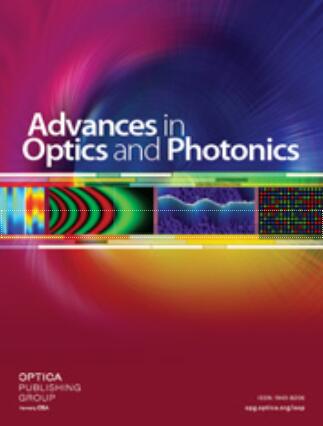非近轴光偏振的几何描述:教程
IF 23.8
1区 物理与天体物理
Q1 OPTICS
引用次数: 7
摘要
本教程概述了非傍轴光偏振的局部描述,电场的所有笛卡尔分量都是重要的。在全偏振的情况下,每个点处的光的偏振由$3$分量矢量表征,或者在部分偏振的情况中由$3\×3$偏振矩阵表征。傍轴偏振的标准概念,如偏振度、斯托克斯参数和庞加莱球,对非傍轴光具有非唯一或非平凡的推广。这项工作旨在澄清其中的一些差异,提出一些新的概念,并提供一个框架,突出与旁轴机制描述的异同。特别强调几何解释。本文章由计算机程序翻译,如有差异,请以英文原文为准。
Geometric descriptions for the polarization of nonparaxial light: a tutorial
This tutorial provides an overview of the local description of polarization for nonparaxial light, for which all Cartesian components of the electric field are significant. The polarization of light at each point is characterized by a $3$ component vector in the case of full polarization or by a $3\times3$ polarization matrix for partial polarization. Standard concepts for paraxial polarization like the degree of polarization, the Stokes parameters and the Poincar\'e sphere then have generalizations for nonparaxial light that are either not unique or not trivial. This work aims to clarify some of these discrepancies, present some new concepts, and provide a framework that highlights the similarities and differences with the description for the paraxial regimes. Particular emphasis is placed on geometric interpretations.
求助全文
通过发布文献求助,成功后即可免费获取论文全文。
去求助
来源期刊

Advances in Optics and Photonics
OPTICS-
CiteScore
56.60
自引率
0.00%
发文量
13
期刊介绍:
Advances in Optics and Photonics (AOP) is an all-electronic journal that publishes comprehensive review articles and multimedia tutorials. It is suitable for students, researchers, faculty, business professionals, and engineers interested in optics and photonics. The content of the journal covers advancements in these fields, ranging from fundamental science to engineering applications.
The journal aims to capture the most significant developments in optics and photonics. It achieves this through long review articles and comprehensive tutorials written by prominent and respected authors who are at the forefront of their fields.
The journal goes beyond traditional text-based articles by enhancing the content with multimedia elements, such as animation and video. This multimedia approach helps to enhance the understanding and visualization of complex concepts.
AOP offers dedicated article preparation and peer-review support to assist authors throughout the publication process. This support ensures that the articles meet the journal's standards and are well-received by readers.
Additionally, AOP welcomes comments on published review articles, encouraging further discussions and insights from the scientific community.
In summary, Advances in Optics and Photonics is a comprehensive journal that provides authoritative and accessible content on advancements in optics and photonics. With its diverse range of articles, multimedia enhancements, and dedicated support, AOP serves as a valuable resource for professionals and researchers in these fields.
 求助内容:
求助内容: 应助结果提醒方式:
应助结果提醒方式:


